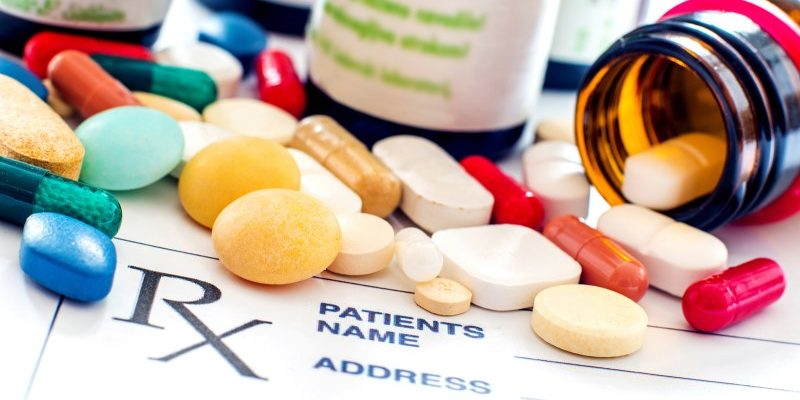
Indication & Usage
-Dyspepsia: Oral: 40 mg once daily for up to 8 weeks.
-Esophagitis: Oral: 20 to 40 mg twice daily for an 8-week trial. Once 8-week trial is complete and remission is achieved, the dose may be gradually lowered.
-Helicobacter pylori eradication: Oral: Clarithromycin triple regimen: 20 to 40 mg twice daily in combination with clarithromycin 500 mg twice daily and either amoxicillin 1 g twice daily or metronidazole 500 mg 3 times daily; continue regimen for 14 days. Eradication rates with clarithromycin-based regimens ≤85%.
-Sequential regimen: 20 mg twice daily plus amoxicillin 1 g twice daily for 5 to 7 days; then continue esomeprazole along with clarithromycin 500 mg twice daily, and either metronidazole or tinidazole 500 mg twice daily for 5 to 7 days.
-Peptic ulcer disease, treatment of complicated ulcers (perforation, penetration, or gastric outlet obstruction): Oral, IV: 40 mg twice daily for 4 weeks, followed by 40 mg once daily. Duration depends on the location and etiology of ulcer.
-Treatment of bleeding peptic ulcers: IV: Continuous infusion: Loading dose of 80 mg, followed by 8 mg/hour continuous infusion for a total of 72 hours, IV: Intermittent dosing: Loading dose of 80 mg, followed by 40 mg every 12 hours
-Prevention of NSAID-induced gastric ulcers: Oral: Esomeprazole: 20 to 40 mg once daily for up to 6 months.
-Gastroesophageal reflux: Oral: Esomeprazole: 20 mg once daily for 4 weeks; may consider an additional 4 weeks of treatment if symptoms do not resolve.
-Pediatric dosing: Erosive esophagitis associated with GERD: Oral: Infants:
3 to 5 kg: 2.5 mg once daily for up to 6 weeks, >5 to 7.5 kg: 5 mg once daily for up to 6 weeks,>7.5 kg: 10 mg once daily for up to 6 weeks.
Children 1 to 11 years: <20 kg: 10 mg once daily for 8 weeks, ≥20 kg: 10 or 20 mg once daily for 8 weeks. Children ≥12 years and Adolescents: 20 to 40 mg once daily for 4 to 8 weeks.
Active Ingredients
Esomeprazole
Recommended Doctors
Dosage & Administration
-Capsule: Swallow whole; do not chew or crush; take at least 1 hour before eating (best if taken before breakfast).
-Granules: Take at least 1 hour before eating. Empty the 2.5 mg or 5 mg packet into a container with 5 mL of water or the 10 mg, 20 mg, or 40 mg packet into a container with 15 mL of water (use double the amount of water if 2 packets are needed) and stir; leave 2 to 3 minutes to thicken. Stir and drink within 30 minutes.
-Tablet: Swallow whole; do not crush or chew; administer with a full glass of water before breakfast in the morning.
-IV infusion: 20 mg in 50 ml (concentration: 0.4 mg/ml) or 40 mg in 50 ml (concentration: 0.8 mg/mL) of D5W, LR, or NS.
-For IV injection (≥3 minutes): Adults: Reconstitute powder with 5 mL NS.
-For IV infusion (10 to 30 minutes): Initially reconstitute powder with 5 ml of NS, LR, or D5W, then further dilute to a final volume of 50 ml.
Side Effects
-Clostridioides difficile-associated diarrhea (CDAD): Use of proton pump inhibitors (PPIs) may increase risk of CDAD, especially in hospitalized patients
-Gastrointestinal infection (eg, Salmonella, Campylobacter): Use of proton pump inhibitors may increase risk of these infections.
-Hypomagnesemia: Reported rarely, usually with prolonged PPI use of ≥3 months (most cases >1 year of therapy). May be symptomatic or asymptomatic; severe cases may cause tetany, seizures, and cardiac arrhythmias.
-Vitamin B12 deficiency: Prolonged treatment (≥2 years) may lead to vitamin B12 malabsorption and subsequent vitamin B12 deficiency.
-Headache, pruritus , decreased serum potassium ,decreased serum sodium, decreased thyroid hormones, increased gastrin, increased serum potassium, increased serum sodium, increased thyroid stimulating hormone level, increased uric acid, acid regurgitation, abdominal pain, constipation, diarrhea, flatulence, nausea, vomiting, xerostomia, increased hemoglobin, increased serum alanine aminotransferase, increased serum alkaline phosphatase, increased serum aspartate aminotransferase, injection site reaction, dizziness, drowsiness, irritability, vertigo, increased serum creatinine, cough, tachypnea, Fever.
Safety Advice
-Esomeprazole should be stopped gradually to avoid worsening or rebound symptoms. One recommendation is to decrease the dose by 50% over 2 weeks to 4 weeks. If the patient is already on the lowest possible dose, alternate day therapy may be considered. If symptoms worsen during treatment or after discontinuation, patient should be re-evaluated.
-In case of Severe renal impairment: Use is not recommended.
-In case of Severe hepatic impairment: Erosive esophagitis, H. pylori eradication or prevention of nonsteroidal anti-inflammatory drug–induced gastric ulcers: the recommended maximum dose is 20 mg once daily.
-Should not be given to patients suffering from Hypersensitivity (eg, anaphylaxis, anaphylactic shock, angioedema, bronchospasm, acute tubulointerstitial nephritis, urticaria) to esomeprazole, other substituted benzimidazole proton pump inhibitors
-Do not use if you have trouble or pain when swallowing food; vomiting with blood, or bloody or black stools; heartburn with light-headedness, dizziness, or sweating; chest pain or shoulder pain with shortness of breath, sweating, pain spreading to arms, neck or shoulders, or light-headedness; frequent chest pain.
-Esomeprazole may falsely elevate serum chromogranin A (CgA) levels. The increased CgA level may cause false-positive results in the diagnosis of a neuroendocrine tumor, temporarily stop esomeprazole ≥14 days prior to assessing CgA level
-Incase of over dose be ready to tell or show what was taken, how much and when it happened, and seek immediate medical attention. For additional information call us on 16676. Always tell your physician your detailed medical history.
Storage
Store at room temperature.
Drug Interactions
-Bisphosphonate Derivatives: Inhibitors of the Proton Pump (PPIs and PCABs) may diminish the therapeutic effect of Bisphosphonate Derivatives.
-Cefpodoxime: Inhibitors of the Proton Pump (PPIs and PCABs) may decrease the serum concentration of Cefpodoxime.
-Cefuroxime: Inhibitors of the Proton Pump (PPIs and PCABs) may decrease the absorption of Cefuroxime.
-Cilostazol: Esomeprazole may increase serum concentrations of the active metabolite(s) of Cilostazol.
-Citalopram: Esomeprazole may increase the serum concentration of Citalopram.
-Clopidogrel: Esomeprazole may diminish the antiplatelet effect of Clopidogrel.
-Escitalopram: Esomeprazole may increase the serum concentration of Escitalopram.
-Itraconazole: Inhibitors of the Proton Pump (PPIs and PCABs) may increase the serum concentration of Itraconazole.
-Methotrexate: Inhibitors of the Proton Pump (PPIs and PCABs) may increase the serum concentration of Methotrexate.
-Multivitamins/Minerals (with vitamins ADEK, Folate, Iron): Inhibitors of the Proton Pump (PPIs and PCABs) may decrease the serum concentration of Multivitamins/Minerals (with vitamins ADEK, Folate, Iron).
-Vitamin K Antagonists (eg, warfarin): Esomeprazole may increase the serum concentration of Vitamin K Antagonists.
Pregnancy & Lactation
-Based on the available data, PPIs may be used when clinically indicated.
-Esomeprazole is present in breast milk, the decision to breastfeed during therapy should consider the risk of infant exposure, the benefits of breastfeeding to the infant, and the benefits of treatment to the mother.

